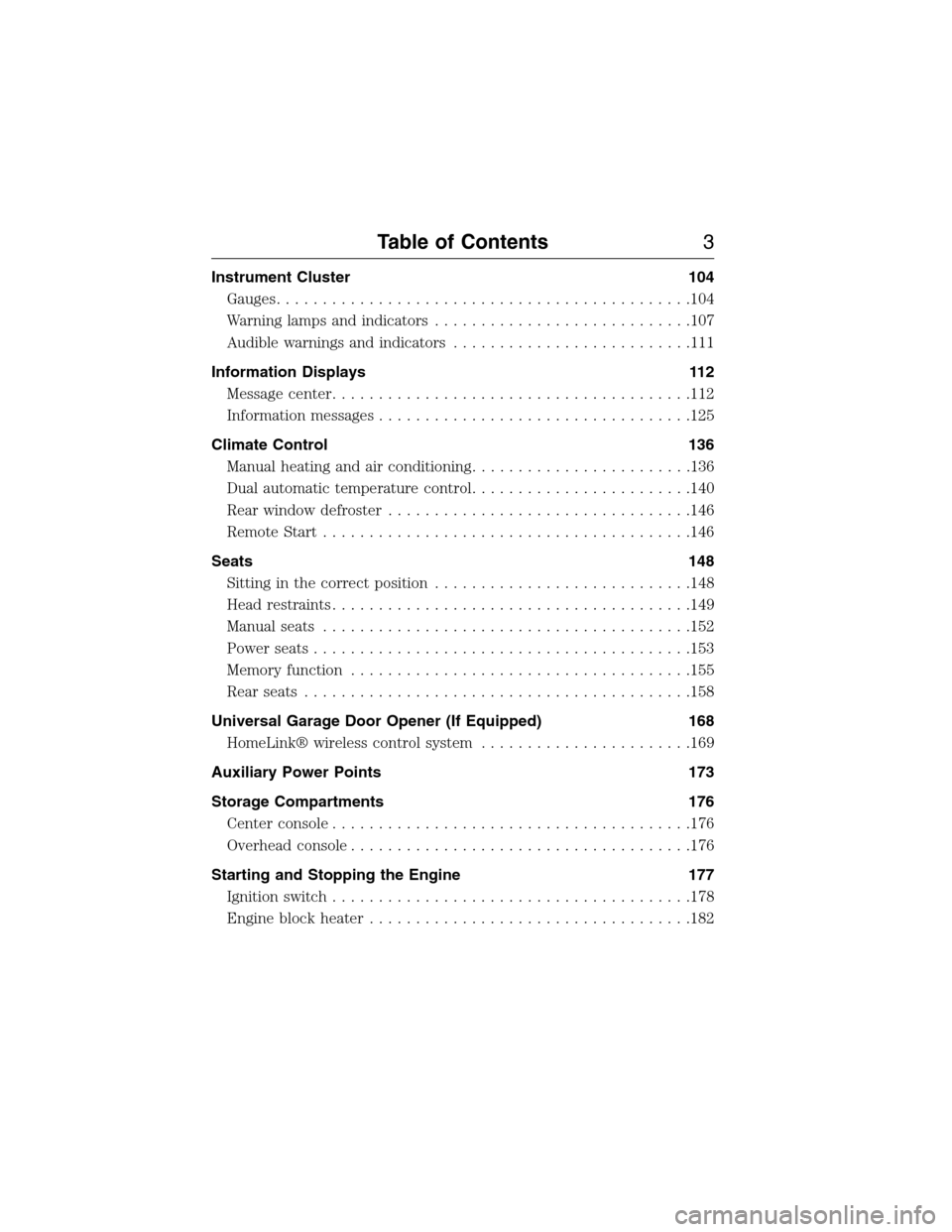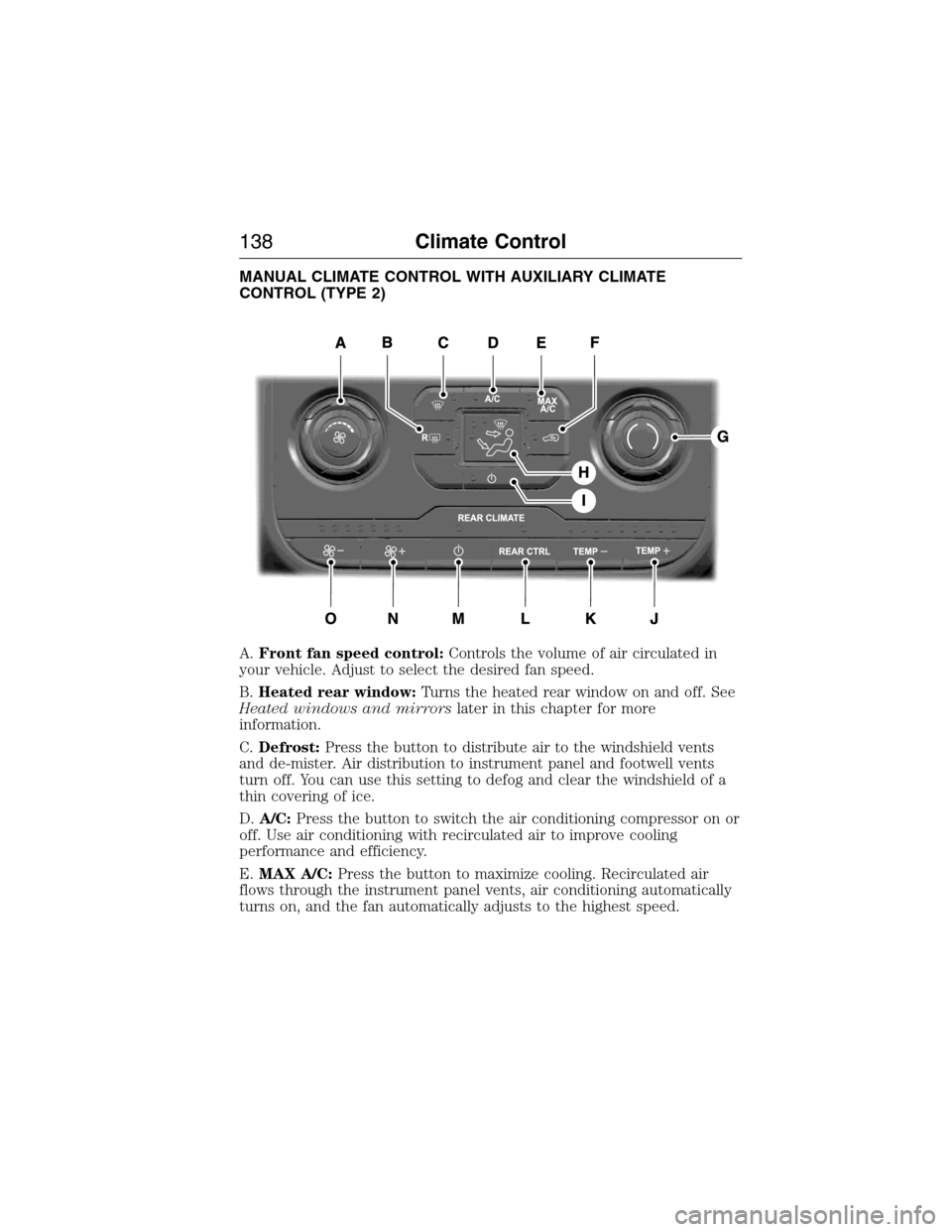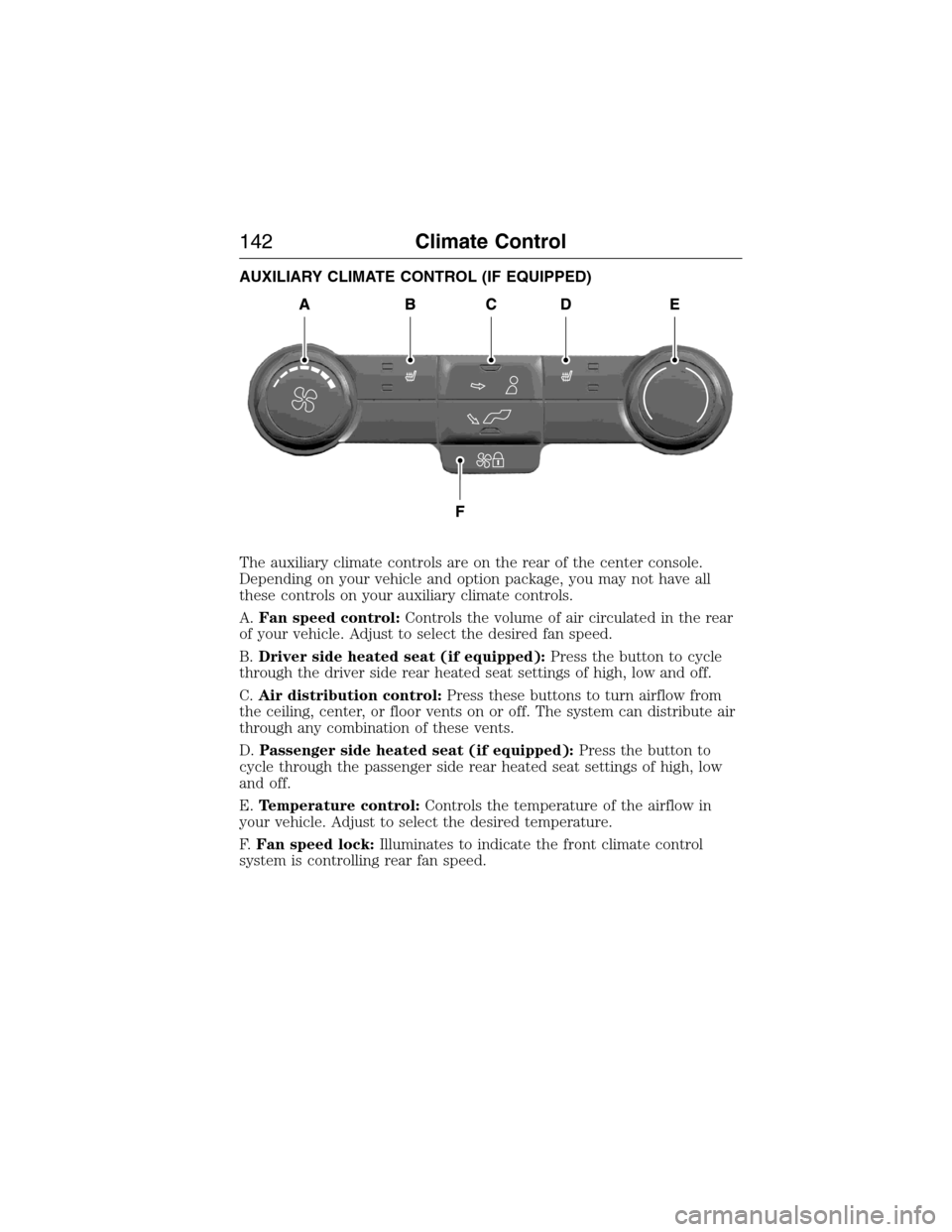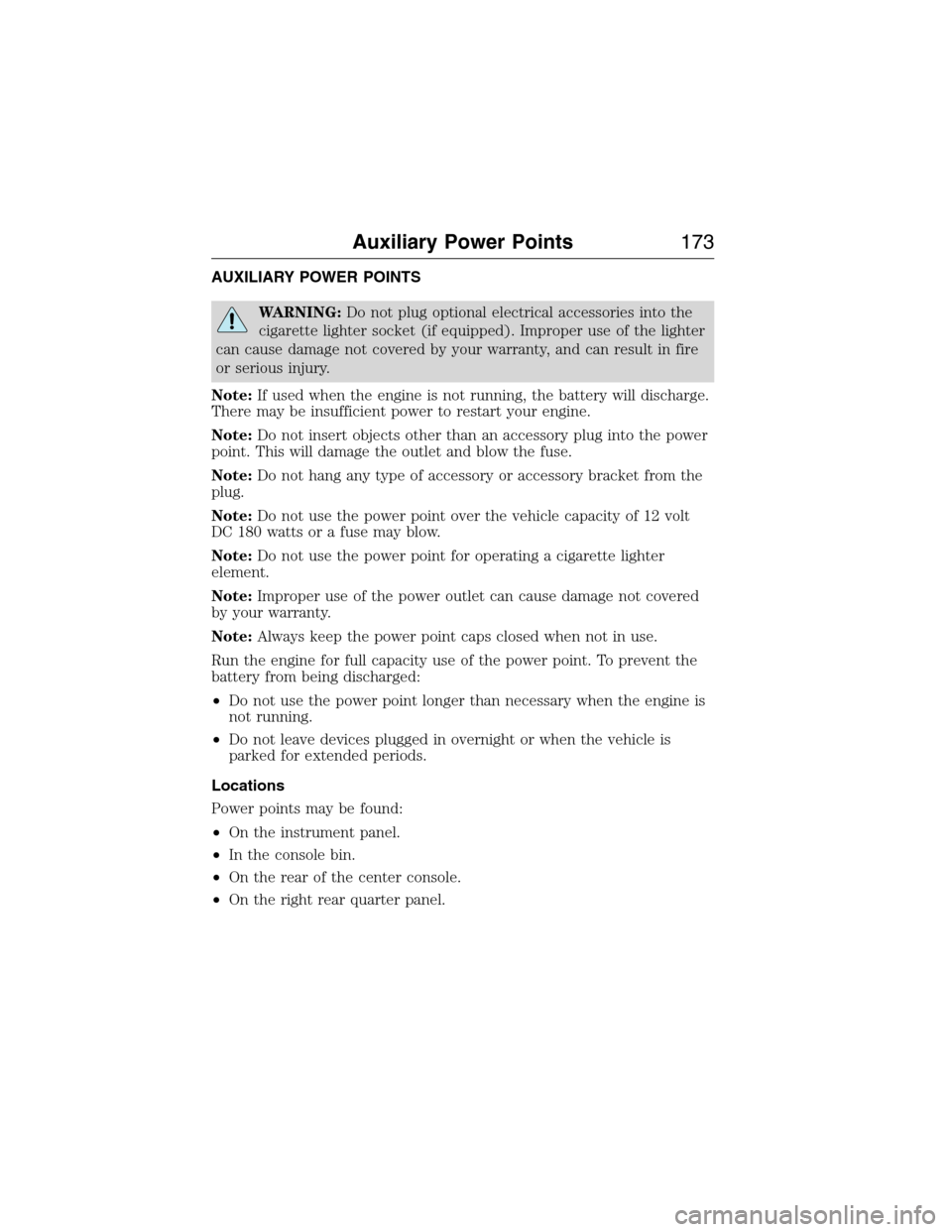2015 FORD EXPEDITION AUX
[x] Cancel search: AUXPage 4 of 564

Instrument Cluster 104
Gauges.............................................104
Warning lamps and indicators............................107
Audible warnings and indicators..........................111
Information Displays 112
Message center.......................................112
Information messages..................................125
Climate Control 136
Manual heating and air conditioning........................136
Dual automatic temperature control........................140
Rear window defroster.................................146
Remote Start........................................146
Seats 148
Sitting in the correct position............................148
Head restraints.......................................149
Manual seats........................................152
Power seats.........................................153
Memory function.....................................155
Rear seats..........................................158
Universal Garage Door Opener (If Equipped) 168
HomeLink® wireless control system.......................169
Auxiliary Power Points 173
Storage Compartments 176
Center console.......................................176
Overhead console.....................................176
Starting and Stopping the Engine 177
Ignition switch.......................................178
Engine block heater...................................182
Table of Contents3
2015 Expedition(exd)
Owners Guide gf, 1st Printing, July 2014
USA(fus)
Page 8 of 564

Wheels and Tires 324
Tire care...........................................326
Tire Pressure Monitoring System (TPMS)...................343
Changing a road wheel.................................347
Technical specifications.................................354
Wheel lug nut torque..................................354
Capacities and Specifications 355
Engine specifications..................................355
Engine drivebelt......................................355
Part numbers........................................360
Vehicle identification number............................361
Vehicle certification label...............................362
Transmission code designation............................362
Accessories 363
Accessories.........................................363
Extended Service Plan 365
Audio System 368
MyFord™ system.....................................370
Rear seat controls.....................................376
Satellite radio information...............................380
Auxiliary input jack...................................383
USBport...........................................384
SYNC® 386
Pairing your phone for the first time.......................391
911 Assist™.........................................405
Vehicle Health Report..................................408
Table of Contents7
2015 Expedition(exd)
Owners Guide gf, 1st Printing, July 2014
USA(fus)
Page 137 of 564

MANUAL CLIMATE CONTROL WITH AUXILIARY CLIMATE
CONTROL (TYPE 1)
A.Front fan speed control:Controls the volume of air circulated in
your vehicle. Adjust to select the desired fan speed.
B.Temperature control:Controls the temperature of the airflow in
your vehicle. Adjust to select the desired temperature.
C.Air distribution control:Turn the control to switch airflow from the
windshield, instrument panel, or footwell vents on or off. The system can
distribute air through any combination of these vents.
MAX A/C:Turn the control to this position to maximize cooling.
Recirculated air flows through the instrument panel vents, air
conditioning automatically turns on, and the fan automatically adjusts
to the highest speed.
D.Auxiliary climate control fan speed:Press to increase the volume
of air circulated in the rear passenger area of the vehicle.
E.REAR (on/off):Press the button to switch the rear climate control
system on and off. or to turn on the auxiliary climate control with the
same settings as the front.
MAX
A/C
REAR R REAR
1
2
3
4
A/CR
A
IHGFED
BC
136Climate Control
2015 Expedition(exd)
Owners Guide gf, 1st Printing, July 2014
USA(fus)
Page 138 of 564

F.REAR (temperature control):Press to turn on the auxiliary climate
control system and to set the desired rear temperature with the front
control. The rear temperature is the same as the front temperature when
only the center rear temperature light (REAR) is lit. The rear
temperature is different from the front temperature when more than one
rear temperature light (REAR) is lit.
G.Heated rear window:Turns the heated rear window on and off. See
Heated windows and mirrorslater in this chapter for more
information.
H.Recirculated air:Press the button to switch between outside air and
recirculated air. When you select recirculated air, the air currently in the
passenger compartment recirculates. This may reduce the time needed
to cool the interior (when used withA/C)and may reduce unwanted
odors from entering your vehicle.
Note:Recirculated air may turn off automatically (or be prevented
from turning on) in all airflow modes exceptMAX A/Cto reduce risk
of fogging.
I.A/C:Press the button to switch the air conditioning compressor on or
off. Use air conditioning with recirculated air to improve cooling
performance and efficiency.
Climate Control137
2015 Expedition(exd)
Owners Guide gf, 1st Printing, July 2014
USA(fus)
Page 139 of 564

MANUAL CLIMATE CONTROL WITH AUXILIARY CLIMATE
CONTROL (TYPE 2)
A.Front fan speed control:Controls the volume of air circulated in
your vehicle. Adjust to select the desired fan speed.
B.Heated rear window:Turns the heated rear window on and off. See
Heated windows and mirrorslater in this chapter for more
information.
C.Defrost:Press the button to distribute air to the windshield vents
and de-mister. Air distribution to instrument panel and footwell vents
turn off. You can use this setting to defog and clear the windshield of a
thin covering of ice.
D.A/C:Press the button to switch the air conditioning compressor on or
off. Use air conditioning with recirculated air to improve cooling
performance and efficiency.
E.MAX A/C:Press the button to maximize cooling. Recirculated air
flows through the instrument panel vents, air conditioning automatically
turns on, and the fan automatically adjusts to the highest speed.
138Climate Control
2015 Expedition(exd)
Owners Guide gf, 1st Printing, July 2014
USA(fus)
Page 143 of 564

AUXILIARY CLIMATE CONTROL (IF EQUIPPED)
The auxiliary climate controls are on the rear of the center console.
Depending on your vehicle and option package, you may not have all
these controls on your auxiliary climate controls.
A.Fan speed control:Controls the volume of air circulated in the rear
of your vehicle. Adjust to select the desired fan speed.
B.Driver side heated seat (if equipped):Press the button to cycle
through the driver side rear heated seat settings of high, low and off.
C.Air distribution control:Press these buttons to turn airflow from
the ceiling, center, or floor vents on or off. The system can distribute air
through any combination of these vents.
D.Passenger side heated seat (if equipped):Press the button to
cycle through the passenger side rear heated seat settings of high, low
and off.
E.Temperature control:Controls the temperature of the airflow in
your vehicle. Adjust to select the desired temperature.
F.Fan speed lock:Illuminates to indicate the front climate control
system is controlling rear fan speed.
142Climate Control
2015 Expedition(exd)
Owners Guide gf, 1st Printing, July 2014
USA(fus)
Page 174 of 564

AUXILIARY POWER POINTS
WARNING:Do not plug optional electrical accessories into the
cigarette lighter socket (if equipped). Improper use of the lighter
can cause damage not covered by your warranty, and can result in fire
or serious injury.
Note:If used when the engine is not running, the battery will discharge.
There may be insufficient power to restart your engine.
Note:Do not insert objects other than an accessory plug into the power
point. This will damage the outlet and blow the fuse.
Note:Do not hang any type of accessory or accessory bracket from the
plug.
Note:Do not use the power point over the vehicle capacity of 12 volt
DC 180 watts or a fuse may blow.
Note:Do not use the power point for operating a cigarette lighter
element.
Note:Improper use of the power outlet can cause damage not covered
by your warranty.
Note:Always keep the power point caps closed when not in use.
Run the engine for full capacity use of the power point. To prevent the
battery from being discharged:
•Do not use the power point longer than necessary when the engine is
not running.
•Do not leave devices plugged in overnight or when the vehicle is
parked for extended periods.
Locations
Power points may be found:
•On the instrument panel.
•In the console bin.
•On the rear of the center console.
•On the right rear quarter panel.
Auxiliary Power Points173
2015 Expedition(exd)
Owners Guide gf, 1st Printing, July 2014
USA(fus)
Page 175 of 564

110 Volt AC Power Point (If Equipped)
WARNING:Do not keep electrical devices plugged in the power
point whenever the device is not in use. Do not use any
extension cord with the 110 volt AC power point, since it will defeat
the safety protection design. Doing so may cause the power point to
overload due to powering multiple devices that can reach beyond the
150–watt load limit and could result in fire or serious injury.
Note:The cap should always be closed whenever the power point outlet
is not in use.
Note:The power point will turn off after 13 minutes if the ignition is on
without the engine running. Keep the engine running to use the power
point.
The 110–volt AC power point outlet is used for powering electrical
devices that require up to 150 watts. Exceeding the 150–watt limit will
cause the power point to cut off the power temporarily to provide
overload protection.
The power point is located on the
back of the center console.
The power point is not designed for the following electric appliances;
they may not work properly:
•Cathode-ray, tube-type televisions
•Motor loads, such as vacuum cleaners, electric saws and other electric
power tools, compressor-driven refrigerators, etc.
•Measuring devices that process precise data, such as medical
equipment, measuring equipment, etc.
•Other appliances requiring an extremely stable power supply:
microcomputer-controlled electric blankets, touch sensor lamps, etc.
174Auxiliary Power Points
2015 Expedition(exd)
Owners Guide gf, 1st Printing, July 2014
USA(fus)